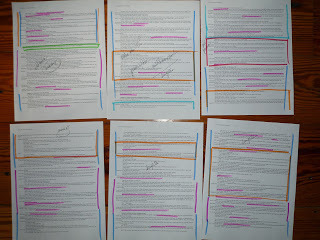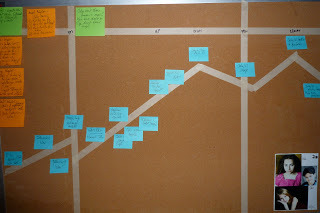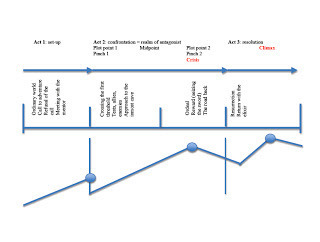Revision! Tools and Techniques
Now that NaNoWriMo is almost over, it’s time for the next step in the process...revision!
Some of you might think that revision is a dirty word. It’s not fun to go over and over something – especially if there seems to be no end in sight.
But I actually prefer revision to writing the first draft. I often don’t plumb my character’s depths until about draft 3; and the plot is pretty messy until draft 6 or 7; and it isn’t until the umpteenth draft that I can play with fun things like language and theme and tone and detail.
In a couple of weeks I’ll talk about holding fast to your initial vision, as you “re-envision” your manuscript, but this week and next I thought I’d share some of the things I do when I revise and some of the tools I find most helpful.
There are 5 specific tools that I use when I revise:
1. taking stock of the “big picture”2. visual aids (charts, photos, graphs)3. checklists4. workbooks5. dedicated passes
 one of my shrunken manuscriptsHere are the first two of these tools as I use them:
one of my shrunken manuscriptsHere are the first two of these tools as I use them:1. Taking stock of the “big picture”
The first thing I do when I’ve finished what I consider the initial draft is put it aside. Not for too long – I need the story’s momentum to keep moving forward – but I give it a few days rest, letting it marinate, and I do something completely different (like eat chocolate...)
After those few days I pick up the manuscript again and read it through, cover to cover. In this process I try to read aloud – there’s something about reading words out loud that allows me to find things that don’t work or sound awkward. (Yes, I get pretty hoarse.) I also try not to stop in the middle and change something huge – I’ll make notes in the margins as I go, but I want to get a feel for the entire scope of the story.
My favorite big picture technique is Darcy Pattison’s “shrunken manuscript”, which allows me to visualize the story at a very large scale. I highly recommend that you find a copy of Darcy’s Novel Metamorphosis , as it contains several similar techniques and one of the others might strike your fancy. But here’s the gist of the shrunken manuscript:Shrink your manuscript to 8 point font, single spacing, with no chapter breaks - you'll be able to read it, just enough to know where you areHighlight areas for different aspects of the manuscript – character development, description, subplots, moments of tension (or lack thereof), etc., etc.Stand back and just look
You’ll see from that distance where you may be missing details of character that are crucial, where your subplots flag or disappear, where you’ve dropped the tension, and so on. This is a great way to discover if your manuscript is too description-heavy, or too action-oriented, or where you may have lost track of a character (as I did while writing my first novel, Faithful, and a main character at that!)
 my plot board with notes and Martha Alderson plotline
2. Visual aids
my plot board with notes and Martha Alderson plotline
2. Visual aids
I’m a visual person, and at some point in crafting a story the only way I can see whether I’ve developed it properly is to see it visually – usually on the wall of my office, where I can spread out the timelines and plotlines together with notes and photographs.
A tool I’ve recently become fond of is Pinterest, and I’ve created boards for each of my novels, allowing me not only to see the pictures that are inspirational to me but also to share those with readers as they develop.
 plot planner in miniatureBy far my favorite visual aid is Martha Alderson’s
PlotWhisperer
plotline (do check out her Plot Whisperer books and other tools.) I’ve made a corkboard with the plotline marked in masking tape, and from there I can use sticky notes to jot down scenes, emotional changes, conflict. Small sticky notes are perfect because I can’t write too much – just enough to direct my thoughts. Plus, I can work in color for different aspects of the story and that appeals to my visual sense.
plot planner in miniatureBy far my favorite visual aid is Martha Alderson’s
PlotWhisperer
plotline (do check out her Plot Whisperer books and other tools.) I’ve made a corkboard with the plotline marked in masking tape, and from there I can use sticky notes to jot down scenes, emotional changes, conflict. Small sticky notes are perfect because I can’t write too much – just enough to direct my thoughts. Plus, I can work in color for different aspects of the story and that appeals to my visual sense.On that board I also post head shots of my characters, and eventually I’ll post a miniature version of Martha’s plotline, one that I’ve integrated with the hero’s journey and other turning points.
Next week I’ll talk about the other revision tools I find helpful – but please share yours here, too!
Published on November 26, 2012 15:11
No comments have been added yet.



